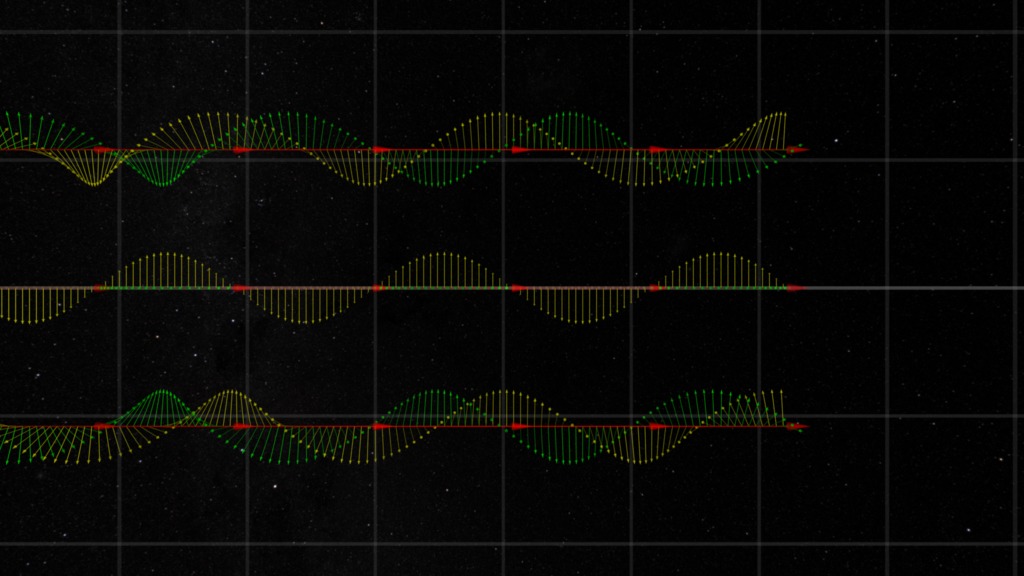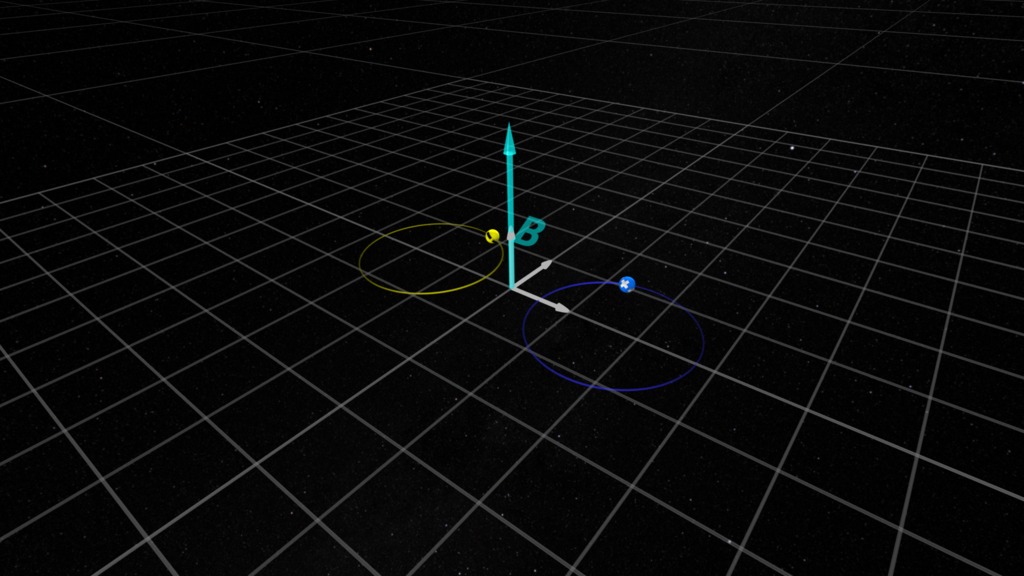Plasma Zoo: Gyroresonant Scattering
In a background magnetic field, represented by the cyan arrows, two electrons are propagating to the right, executing identical gyromotion. A circularly polarized electromagnetic wave approaches the upper electron from the left.
In regions like planetary magnetospheres, a number of more complex interactions can occur between charged particles, fields, and electromagnetic waves. One of these processes is called gyroresonant scattering or alternatively pitch-angle scattering.
In gyroresonant scattering, a charged particle undergoing gyromotion in a background magnetic field interacts with the electric field of a circularly-polarized electromagnetic wave. To the moving particle, the wave appears Doppler-shifted, and if this Doppler-shifted wave frequency is close to the gyro-frequency, the rotating electric field of the wave and add or remove energy from the particle. In the case of a uniform background magnetic field this 'pumping' of energy into and out of the particle can occur all along the particle trajectory. However, if the background magnetic field varies along the particle trajectory, the wave may get only one opportunity to inject or remove energy from the particle.
When this process acts on a collection of particles of different energies and pitch-angles, the process can alter the distribution of energy and pitch angles. This process may be responsible for the 'flushing' of electrons out of some regions of the radiation belts by VLF radio waves, and 'bunching' of other particles.

As the upper electron begins to interact with the wave, the electric field of wave is initially oriented in a way that removes energy from the particle, slowing its speed perpendicular to the magnetic field, which makes the pitch angle (the angle between the particle velocity vector and the magnetic field vector) and gyro-radius smaller.

As the wave field decelerates the electron, its gyro-frequency gets closer matched to the electromagnetic wave. If the electric field is directed radially with the gyromotion, the particle is no longer accelerated by the electric field and the particle 'surfs' the wave, the energy no longer changing (and the particle trail is white).

After a few more orbits, the particle gyromotion is again decelerated (trail turns blue) but also picks up some speed along the field line, moving it ahead of the particle outside the wave.

The increasing magnetic field gradient moves the particle gyrofrequency well past the resonance condition. Then the particle oscillates between losing small amounts of energy (blue trail) and gaining small amounts of energy (red trail), with little changes to total energy as it propagates in the wave.

The particle in the wave is now well ahead of the particle outside the wave.
An oblique view of the interaction, with the camera moving ahead of the particles and looking back on their motion. This view makes the gyromotion of the particles, and the circular polarization of the waves more obvious.

Color bar for the particle trails. White means no change in particle energy, blue means losing energy and red means gaining energy.
For More Information
See NASA.gov
Credits
Please give credit for this item to:
NASA's Scientific Visualization Studio
-
Data visualizer
- Tom Bridgman (Global Science and Technology, Inc.)
-
Writer
- Mara Johnson-Groh (Wyle Information Systems)
-
Scientists
- Alex Boyd (New Mexico Consortium)
- Geoff Reeves (New Mexico Consortium & Los Alamos National Laboratory)
-
Project support
- Laurence Schuler (ADNET Systems, Inc.)
- Ian Jones (ADNET Systems, Inc.)
Release date
This page was originally published on Tuesday, May 29, 2018.
This page was last updated on Monday, January 6, 2025 at 12:12 AM EST.
Series
This page can be found in the following series:Related papers
Datasets used
-
ParticleSimulator
ID: 846
Note: While we identify the data sets used on this page, we do not store any further details, nor the data sets themselves on our site.


